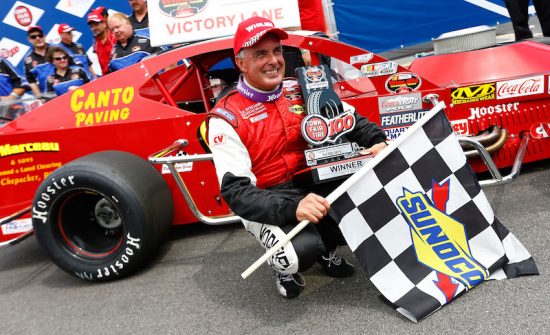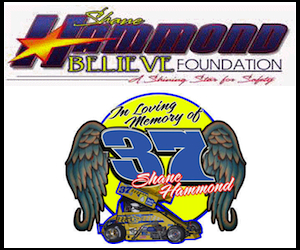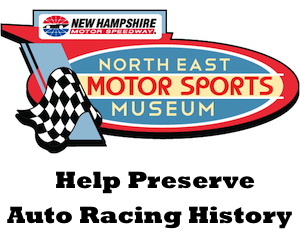(Press Release from NASCAR Integrated Marketing Communications)

The late Mike Stefanik will receive the call to the NASCAR Hall of Fame on Friday night, an honor that recognizes his racing accomplishments as a nine-time champion at the regional series level.
Stefanik excelled in cars with fenders and those without – thriving in the former Busch Grand National North Series and the open-wheel NASCAR Whelen Modified Tour. That dominance led to a handful of national series starts in what’s now called the Xfinity Series, and a brief stint in the Camping World Truck Series. He became that circuit’s Rookie of the Year in his lone Truck season, a standout newcomer at age 41.
Stefanik never ran a Cup Series race, but he was exceptional at the tracks where NASCAR’s top division competed. At tiny Martinsville Speedway, Stefanik won five times when the northeast-based Modified Tour ventured south to Virginia. Closer to his Rhode Island home, he was an eight-time Modified winner at New Hampshire Motor Speedway, adding a pair of Busch North wins to his tally at the relatively flat mile track.
Both of those totals top the all-time win list at Martinsville and New Hampshire since the Modified Tour’s modern era was established in 1985. The last of his 74 tour victories came at another Cup Series mainstay – Bristol Motor Speedway in 2013. He died six years later in an ultralight airplane crash near the Connecticut-Rhode Island border.
Winston Kelley, the NASCAR Hall’s executive director, has often said the shrine is a NASCAR Hall of Fame and not solely a Cup Series Hall of Fame. Stefanik fits that all-encompassing description, but his success on the grand stages of Cup Series tracks – especially at Martinsville and New Hampshire — is a distinction all its own.
With Stefanik’s induction night approaching Friday (8 p.m. ET, streaming on Peacock) along with fellow honorees Dale Earnhardt Jr. and Red Farmer, NASCAR.com spoke with two longtime institutions in the racing industry with deep connections to those tracks, gathering their remembrances of Stefanik’s enduring excellence. Their interviews have been lightly edited for length and clarity.
Mastery at Martinsville
Clay Campbell grew up with Modified racing as a regular tradition at the track his grandfather, H. Clay Earles, founded near NASCAR’s origin date. Mike Stefanik played a significant role in writing that history.
Campbell is now president of Martinsville Speedway, which celebrates its 75th anniversary season this year. The Whelen Modified Tour returned to the .526-mile track last season after an 11-year absence, but its previous run at Martinsville was marked by Stefanik’s staying power. The first of his five Martinsville wins came in 1989; his last, in 2009. Campbell was there for all of them.
Clay Campbell: “That all goes way back to when I was a child with the Modified Series coming here and running the doubleheader along at that time with Sportsman, but it was always big. And I think that that kind of points to the relationship, or maybe not even a relationship but the friendship that I had with Mike, because this place was always special to the Mod guys to come down. I mean, it was their annual pilgrimage coming down on the spring for the March race and then the fall race in October.
“And they always looked forward to it because they said this was their big race, and it meant a lot to them. So it’s really neat now to rekindle that relationship with the Modified guys and have them back here and running at the speedway. The Modified Tour’s always been special to Martinsville. That goes back to my grandfather — they meant a lot to him and it does to me as well.
“I think how our friendship began was you know, Mike coming down and he had five wins here at Martinsville, so that that’s pretty darn good for any guy to have. So obviously I got to see him in Victory Lane five times, for sure. But it was always Mike and his wife, Julie. I mean, they were together all the time. I remember one particular case, and I’m not sure exactly which year it was, but it was a Modified Tour banquet up north. Me and my wife sat with Mike and Julie, just had a wonderful time. I mean, they’re great people.
“Mike was just one of the kindest people I’ve met, and to be a competitor, when you strap the helmet on and get out there in competition, you have to be different. But as far as the Mike Stefanik that I knew, he was a great guy. I went to his visitation and saw Julie, and you know, it’s hard to say when you only see people twice a year that they’re good friends or you consider them family, but in that case, you kind of did. There’s some people you just have a natural attraction to or you have a bond with them that you know, some people it takes seeing them all the time to do that. Mike was not that way with me. Anytime we saw one another it was like we just saw each other last week. I always thought a lot of Mike, and he was just a special guy to me.
“There are some drivers that have run here for years and years that never figure out. And there’s some that, in Mike’s case, he took it and he adapted to it. It is a difficult track and especially for Modifieds. I mean, they’re the fastest car that runs here, so to get around here in the times and speeds that those guys do to figure it out and be as successful as Mike was, that says a lot about his power behind the wheel. And obviously he had it.
“Twenty years between wins and to still maintain that drive and still put it on the line to do it, that makes him … just that in itself makes him a special individual. In 20 years, things change — your reflexes change, things in your head change, and let’s face it. Modifieds here, that’s a true race car that you’ve really got to be on your A-game to succeed at it, and he did it from 1989 until 2009. That’s phenomenal.
“I would say if Mike was here, and you asked him when he got started in Modifieds, did he ever have the ambition or the desire or even the inkling that he would ultimately go in the Hall of Fame, and I’m sure he would have said no, and I’m sure he would’ve said, ‘You know, I love doing Modified racing and that’s where I want to stay.’ Although I know he did dabble in Busch Grand National at the time, things like that, it speaks volumes for all the guys all across this country that are running weekly tracks every Friday night, Saturday night, that it’s doable. You can do it. Look at Mike Stefanik, and to go in the Hall of Fame with the guys he’s going in with, I think that’s great.
“The only bad thing about it is he’s not here to go in himself. I think Mike Stefanik embodies what NASCAR is all about. It’s just a shame. He’s gone too early.”
Back-home success at NHMS
Dick Berggren’s racing chops are unquestioned, spanning multiple areas of the sport for decades. After a start as a racer and car owner in the northeast, he became better known later as a veteran journalist – both as a founder and trusted editor of national motorsports magazines and a reliable broadcaster and pit-road reporter for televised NASCAR coverage. He continues his involvement with the sport as the president of the North East Motor Sports Museum, which neighbors the 1.058-mile New Hampshire Motor Speedway on state route 106.
Berggren’s roots with the Stefanik family run deep, all the way back to humble beginnings before Stefanik’s ability had taken hold in the racing community. But Berggren’s career also made charting Stefanik’s rise a necessity and a priority, and the racer continually wowed him at New Hampshire – a venue with special prominence for the Modified Tour.
Dick Berggren: “Well, certainly one of the memories I have of him is when his wife, Julie, was his spotter, and just seeing how the two of them interacted over the course of a race. They weren’t just husband and wife. I mean, if he didn’t pick the lane she wanted him to pick, he heard about it on the radio. They were just very, very good together. It just seemed as if you saw Mike Stefanik, Julie was nearby. If you saw Julie, Mike was nearby. They were as solid a couple as I have ever known. I mean, it’s just … his departure just has broken her heart, and I can understand that.
“Another thing to share with you is his racing, the way he raced. He was tough, he was aggressive, but by the same token, when I think back to all the laps I watched that guy, I don’t remember him ever putting a bumper on somebody else to move them out of the way. If he couldn’t pass fairly and easily and get the spot, he wasn’t going to spin somebody out. He wasn’t going to move somebody up a lane. That just wasn’t his way of racing, and I appreciate that. I know that’s not what’s going on anywhere in the racing world in the United States anymore, but it’s the way I like racing to be, and Mike Stefanik did it and he did it well.
“First time I met him, I found him in a basic one-and-a-half-car garage, working on a race car all by himself. It was an early morning, and I just thought to myself — this is before anybody knew who Mike Stefanik was; he hadn’t really done anything yet — I thought to myself, this guy’s working this hard this early in the morning on his race car. This is a good thing. Maybe this guy’ll be somebody someday. He really did turn out to be quite somebody someday, didn’t he?
“He was so good at New Hampshire Motor Speedway. I mean, that’s a tough joint. It really is. You’ve got very high speeds, very long straightaways. So there’s a lot of speed going into both one and three turns, and a lot of people never figure out how to do that. The track being very flat, you don’t get any help from the banking. You’ve just got to control the car with your brake, your throttle and your steering wheel. You’re in charge. You don’t get any help from banking, and he seemed to figure it out very quickly. He was so good at New Hampshire Motor Speedway, I mean, so smooth and you never saw the car wiggle. You can tell by looking at him, he was right on the edge, but you’d never see the car wiggle. He was always in control.
“I can only think of a couple of other people who were as good as they were in Modifieds and also as good as that in the Busch North car. (Mike) ‘Magic Shoes’ McLaughlin was one of those. Teddy Christopher’s the other. It’s a small club — three people that could do that. And of course, Stefanik was — of the three of them — I think Stefanik was the best at it. I mean, he won championships in both series, and the other two guys did not.
“All three of this year’s class excelled on little, tiny race tracks and great big superspeedways as well. And they did it for a reasonably long time. I mean, it’s too bad (Dale) Junior didn’t have more time in his career. I would like to see what else he could have done if he was able to race longer than he did. But the three of them, it’s just an incredible class of very gifted and very talented people who all had in common in their racing days that they did the best they could to entertain their fans and build NASCAR as a sport that people wanted to buy tickets for and wanted to see.
“All three of this year’s new Hall of Famers are people who helped the sport a lot in what they did. They all had time for fans, they all had just wonderful records on the race track, and they helped build the sport. There’s no other people that are in that situation. We get three of them going to the Hall of Fame all at once.
“I think his legacy is that of a winner and that of a champion and that of a man who lived his life well and set his goals and accomplished them — and basically was somebody who you could point to and say, ‘I’d like to be more like that person. I’d like to be more like Mike Stefanik.’ Certainly, I’m in that category. I wish I was, but I’m not. He was very, very special. His passing was a huge loss to so many.”



















Mighty Mike,, great innovator,, great racer,, great racing family,, gone too soon..
Nice tribute.
Very nice tribute to a GREAT race car driver. RIP